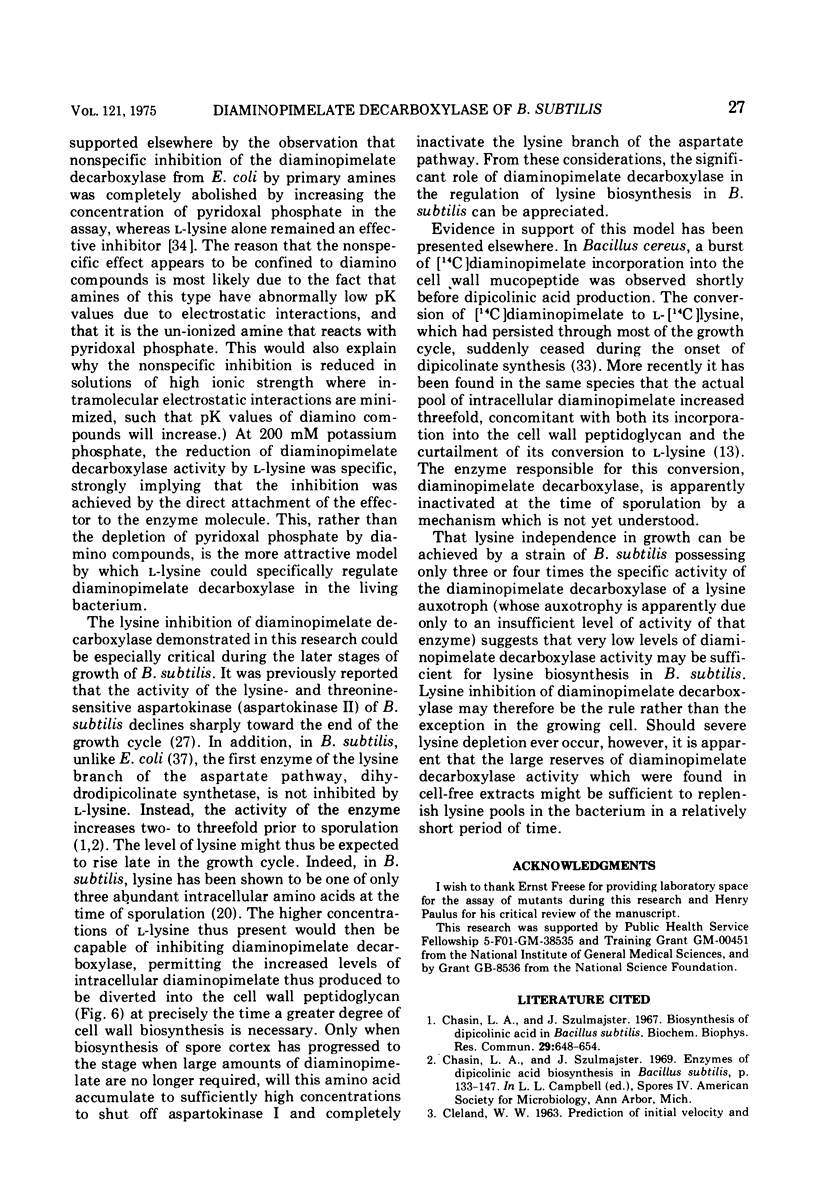Abstract
Diaminopimelate decarboxylase has been characterized in extracts of Bacillus subtilis and resolved from aspartokinases I and II. Under certain conditions, the enzyme is specifically inhibited by physiological concentrations of L-lysine, but less specificity and altered kinetics of inhibition are observed if lower ionic strengths are employed in the assay procedure. Diaminopimelate decarboxylase can be desensitized to lysine inhibition by either lowering the pH or diluting the enzyme in Tris buffer in the absence of pyridoxal phosphate. Evidence is presented to incidate that, under proper conditions, lysine inhibition involves an interaction of the amino acid with the enzyme rather than competition for available pyridoxal phosphate in the assay. Lysine, by affecting the level of meso-diaminopimelate, may thus regulate its biosynthesis through sequential feedback inhibition. Analysis of the diaminopimelate decarboxylase of 15 revertants of mutants that had originally lacked diaminopimelate decarboxylase activity indicates that as little as 5% of the specific activity of enzyme observed in the wild-type strain is sufficient to permit normal growth rates. In the growing cell, diaminopimelate decarboxylase may therefore exist largely in an inhibited state.
Full text
PDF








Selected References
These references are in PubMed. This may not be the complete list of references from this article.
- CLELAND W. W. The kinetics of enzyme-catalyzed reactions with two or more substrates or products. III. Prediction of initial velocity and inhibition patterns by inspection. Biochim Biophys Acta. 1963 Feb 12;67:188–196. doi: 10.1016/0006-3002(63)91816-x. [DOI] [PubMed] [Google Scholar]
- Cafferata R. L., Freundlich M. Evidence for a methionine-controlled homoserine dehydrogenase in Salmonella typhimurium. J Bacteriol. 1969 Jan;97(1):193–198. doi: 10.1128/jb.97.1.193-198.1969. [DOI] [PMC free article] [PubMed] [Google Scholar]
- Chasin L. A., Szulmajster J. Biosynthesis of dipicolinic acid in Bacillus subtilis. Biochem Biophys Res Commun. 1967 Dec 15;29(5):648–654. doi: 10.1016/0006-291x(67)90265-3. [DOI] [PubMed] [Google Scholar]
- DEWEY D. L., WORK E. Diaminopimelic acid decarboxylase. Nature. 1952 Mar 29;169(4300):533–534. doi: 10.1038/169533a0. [DOI] [PubMed] [Google Scholar]
- Datta P., Prakash L. Aspartokinase of Rhodopseudomonas spheroides. Regulation of enzyme activity by aspartate beta-semialdehyde. J Biol Chem. 1966 Dec 25;241(24):5827–5835. [PubMed] [Google Scholar]
- Dunathan H. C. Conformation and reaction specificity in pyridoxal phosphate enzymes. Proc Natl Acad Sci U S A. 1966 Apr;55(4):712–716. doi: 10.1073/pnas.55.4.712. [DOI] [PMC free article] [PubMed] [Google Scholar]
- EGGLESTON L. V. The effects of phosphates, arsenates and nucleotides on L-amino acid decarboxylases. Biochem J. 1957 Apr;65(4):735–744. doi: 10.1042/bj0650735. [DOI] [PMC free article] [PubMed] [Google Scholar]
- GIBSON K. D., NEUBERGER A., TAIT G. H. Studies on the biosynthesis of prophyrin and bacteriochlorophyll by Rhodoseudomonas spheroides. 3. The effect of threonine on the biosynthesis of homoserine and methionine. Biochem J. 1962 Sep;84:483–490. doi: 10.1042/bj0840483. [DOI] [PMC free article] [PubMed] [Google Scholar]
- Grandgenett D. P., Stahly D. P. Control of diaminopimelate decarboxylase by L-lysine during growth and sporulation of Bacilluscereus. J Bacteriol. 1971 May;106(2):551–560. doi: 10.1128/jb.106.2.551-560.1971. [DOI] [PMC free article] [PubMed] [Google Scholar]
- Grandgenett D. P., Stahly D. P. Diaminopimelate decarboxylase of sporulating bacteria. J Bacteriol. 1968 Dec;96(6):2099–2109. doi: 10.1128/jb.96.6.2099-2109.1968. [DOI] [PMC free article] [PubMed] [Google Scholar]
- Grandgenett D. P., Stahly D. P. Repression of diaminopimelate decarboxylase by L-lysine in different Bacillus species. J Bacteriol. 1971 Mar;105(3):1211–1212. doi: 10.1128/jb.105.3.1211-1212.1971. [DOI] [PMC free article] [PubMed] [Google Scholar]
- Kuramitsu H. K., Yoshimura S. Catalytic and regulatory properties of meso-diaminopimelate-sensitive aspartokinase from Bacillus stearothermophilus. Arch Biochem Biophys. 1971 Dec;147(2):683–691. doi: 10.1016/0003-9861(71)90428-0. [DOI] [PubMed] [Google Scholar]
- LUCAS N., KING H. K., BROWN S. J. Substrate attachment in enzymes. The interaction of pyridoxal phosphate with amino acids. Biochem J. 1962 Jul;84:118–124. doi: 10.1042/bj0840118. [DOI] [PMC free article] [PubMed] [Google Scholar]
- PATTE J. C., LE BRAS G., LOVINY T., COHEN G. N. [Retro-inhibition and repression of the homoserine dehydrogenase of Escherichia coli]. Biochim Biophys Acta. 1963 Jan 8;67:16–30. doi: 10.1016/0006-3002(63)91793-1. [DOI] [PubMed] [Google Scholar]
- PATTE J. C., LOVINY T., COHEN G. N. [Repression of meso-alpha, epsilon-diaminopimelic acid decarboxylase by L-lysine in Escherichia coli]. Biochim Biophys Acta. 1962 Apr 9;58:359–360. doi: 10.1016/0006-3002(62)91024-7. [DOI] [PubMed] [Google Scholar]
- Patte J. C., Le Bras G., Cohen G. N. Regulation by methionine of the synthesis of a third aspartokinase and of a second homoserine dehydrogenase in Escherichia coli K 12. Biochim Biophys Acta. 1967 Mar 22;136(2):245–247. doi: 10.1016/0304-4165(67)90069-4. [DOI] [PubMed] [Google Scholar]
- Paulus H., Gray E. Multivalent feedback inhibition of aspartokinase in Bacillus polymyxa. I. Kinetic studies. J Biol Chem. 1967 Nov 10;242(21):4980–4986. [PubMed] [Google Scholar]
- Rosner A., Paulus H. Regulation of aspartokinase in Bacillus subtilis. The separation and properties of two isofunctional enzymes. J Biol Chem. 1971 May 10;246(9):2965–2971. [PubMed] [Google Scholar]
- Spizizen J. TRANSFORMATION OF BIOCHEMICALLY DEFICIENT STRAINS OF BACILLUS SUBTILIS BY DEOXYRIBONUCLEATE. Proc Natl Acad Sci U S A. 1958 Oct 15;44(10):1072–1078. doi: 10.1073/pnas.44.10.1072. [DOI] [PMC free article] [PubMed] [Google Scholar]
- Tempest D. W., Meers J. L., Brown C. M. Influence of environment on the content and composition of microbial free amino acid pools. J Gen Microbiol. 1970 Dec;64(2):171–185. doi: 10.1099/00221287-64-2-171. [DOI] [PubMed] [Google Scholar]
- Tipper D. J., Pratt I. Cell wall polymers of Bacillus sphaericus 9602. II. Synthesis of the first enzyme unique to cortex synthesis during sporulation. J Bacteriol. 1970 Aug;103(2):305–317. doi: 10.1128/jb.103.2.305-317.1970. [DOI] [PMC free article] [PubMed] [Google Scholar]
- WHITE P. J., KELLY B. PURIFICATION AND PROPERTIES OF DIAMINOPIMELATE DECARBOXYLASE FROM ESCHERICHIA COLI. Biochem J. 1965 Jul;96:75–84. doi: 10.1042/bj0960075. [DOI] [PMC free article] [PubMed] [Google Scholar]
- White P. J., Kelly B., Suffling A., Work E. Variation of activity of bacterial diaminopimelate decarboxylase under different conditions of growth. Biochem J. 1964 Jun;91(3):600–610. doi: 10.1042/bj0910600. [DOI] [PMC free article] [PubMed] [Google Scholar]
- YUGARI Y., GILVARG C. Coordinate end-product inhibition in lysine synthesis in Escherichia coli. Biochim Biophys Acta. 1962 Aug 27;62:612–614. doi: 10.1016/0006-3002(62)90256-1. [DOI] [PubMed] [Google Scholar]


